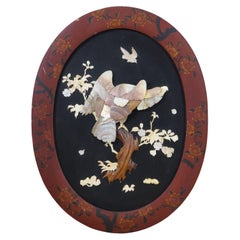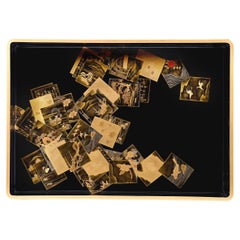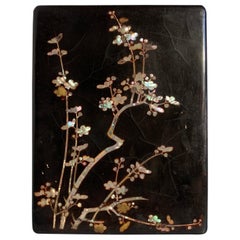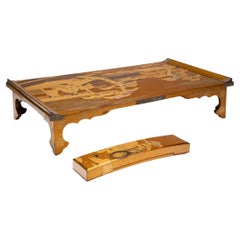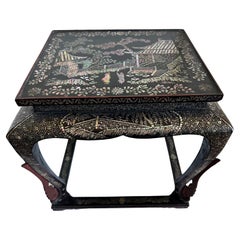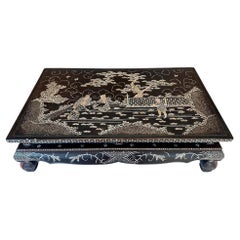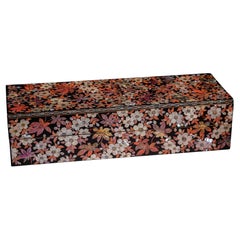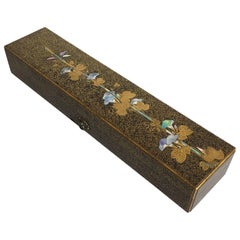Japanese Lacquer Pearl
Early 20th Century Japanese Meiji Lacquer
Mother-of-Pearl, Hardwood, Lacquer
Antique Late 19th Century Japanese Meiji Lacquer
Gold
Antique 16th Century Japanese Edo Lacquer
Lacquer, Abalone
Early 20th Century Japanese Meiji Lacquer
Mother-of-Pearl, Wood
Antique 18th Century Japanese Edo Lacquer
Mother-of-Pearl, Lacquer
Antique 18th Century Japanese Japonisme Lacquer
Mother-of-Pearl, Lacquer
Antique 18th Century Japanese Edo Lacquer
Mother-of-Pearl, Lacquer
Antique Late 19th Century Japanese Meiji Lacquer
Mother-of-Pearl, Wood, Lacquer
Antique Early 19th Century Japanese Edo Lacquer
Mother-of-Pearl, Lacquer
Antique Early 1900s Japanese Meiji Lacquer
Silver
Antique Mid-18th Century Japanese Lacquer
Lacquer, Mother-of-Pearl
Antique 19th Century Japanese Lacquer
Brass, Lead
Antique 19th Century Japanese Edo Scholar's Objects
Copper
Antique 19th Century Italian Japonisme Furniture
Shell, Wood
Early 20th Century Japanese Side Tables
Mother-of-Pearl, Wood, Lacquer
Antique 19th Century Japanese Meiji Furniture
Mother-of-Pearl, Wood
Early 20th Century Japanese Meiji Decorative Boxes
Wood
Antique Late 19th Century Japanese Meiji Decorative Art
Bone, Mother-of-Pearl, Lacquer
20th Century Japanese Other Furniture
Mother-of-Pearl
Antique Late 19th Century Japanese Meiji Furniture
Gold
Early 20th Century Japanese Japonisme Antiquities
Lacquer
Early 20th Century Japanese Art Deco Jewelry Boxes
Mother-of-Pearl, Wood, Lacquer
20th Century Japanese Paintings and Screens
Bone, Mother-of-Pearl, Wood
Antique Late 19th Century Japanese Anglo-Japanese Decorative Boxes
Abalone, Mother-of-Pearl, Wood, Lacquer
Antique Early 19th Century Korean Scholar's Objects
Brass
Antique Late 19th Century Japanese Japonisme Decorative Art
Shell, Bone, Mother-of-Pearl, Lacquer
Antique Late 19th Century Japanese Meiji Furniture
Wood, Mother-of-Pearl, Lacquer
Antique 19th Century Japanese Edo Scholar's Objects
Bronze
Antique 19th Century Japanese Meiji Paintings and Screens
Mother-of-Pearl, Wood, Lacquer
Antique 19th Century Japanese Meiji Furniture
Mother-of-Pearl, Wood, Lacquer
Early 20th Century Japanese Edo Decorative Boxes
Copper
Mid-20th Century Japanese Japonisme End Tables
Abalone, Mother-of-Pearl, Hardwood
Mid-20th Century Japanese Japonisme End Tables
Abalone, Mother-of-Pearl, Hardwood
20th Century Japanese Decorative Art
Mother-of-Pearl, Wood
Antique Late 19th Century Japanese Other Lacquer
Lacquer
Antique Early 1900s Japanese Napoleon III Lacquer
Mother-of-Pearl, Paint
2010s Japanese Minimalist Lacquer
Mother-of-Pearl, Hemp, Bamboo, Lacquer
20th Century Japanese Lacquer
1990s Japanese Lacquer
Gold
Antique Late 19th Century Japanese Meiji Furniture
Mother-of-Pearl, Wood
Antique 19th Century Japanese Boxes
Wood, Lacquer, Mother-of-Pearl
Antique 19th Century Japanese End Tables
Brass
Antique Late 19th Century Japanese Meiji Tobacco Accessories
Bronze
Antique Late 18th Century Japanese Decorative Objects
Metal
Antique Late 19th Century Japanese Meiji Decorative Boxes
Mother-of-Pearl, Lacquer
Antique Late 19th Century Japanese Japonisme Cabinets
Ivory, Mother-of-Pearl, Hardwood, Lacquer
Antique Early 19th Century Japanese Other Antiquities
Copper, Silver
Antique 1850s English Victorian Dessert Tables and Tilt-top Tables
Mother-of-Pearl, Wood, Lacquer
Early 20th Century Japanese Lacquer
Lacquer, Mother-of-Pearl
Antique 18th Century Japanese Edo Lacquer
Coral, Pewter, Gold, Copper
Early 20th Century Japanese Lacquer
Mother-of-Pearl, Wood, Lacquer
Early 20th Century Japanese Taisho Lacquer
Pewter
Antique Early 18th Century Japanese Japonisme Lacquer
Mother-of-Pearl, Wood, Lacquer
1990s Japanese Other Lacquer
Mother-of-Pearl, Wood
Antique Late 19th Century Japanese Japonisme Lacquer
Bone, Abalone, Mother-of-Pearl, Wood
Antique Early 1900s Japanese Meiji Lacquer
Mother-of-Pearl, Lacquer
20th Century Japanese Lacquer
Mother-of-Pearl, Lacquer
- 1
Japanese Lacquer Pearl For Sale on 1stDibs
How Much is a Japanese Lacquer Pearl?
- 1stDibs ExpertApril 5, 2022Japanese lacquer is made of resin produced from the sap of the Urushi tree. Artisans craft bowls, vases, boxes and other items out of the material. Find a collection of Japanese lacquer furniture and decorative objects and art on 1stDibs.
- 1stDibs ExpertApril 5, 2022You can restore Japanese lacquer that has been damaged by exposure to light by gently buffing it with carnauba wax. Use a soft cloth to gently rub the wax into the piece, removing any excess and avoiding undamaged lacquer. Take a look on 1stDibs for a variety of pieces featuring Japanese lacquer.
- 1stDibs ExpertApril 5, 2022To clean a Japanese lacquer box, start by moistening a soft lint-free cloth with warm water. Ring it out and then gently rub every surface. Do not use soap as it may damage the lacquer. Dry the box promptly with a second soft, dry lint-free cloth. On 1stDibs, find a variety of Japanese lacquer boxes.
- 1stDibs ExpertApril 5, 2022To fix Japanese black lacquer, take it to a furniture repair shop that has previously worked with the material. Lacquer is very delicate. Attempting to fix a piece on your own could cause further damage. On 1stDibs, find a selection of Japanese black lacquer.
- 1stDibs ExpertApril 5, 2022Japanese lacquerware items are finished with a sap that comes from the lacquer tree. This finish is prone to degradation, especially if exposed to sun and water, and age will take its toll as well. To clean lacquerware items, wet a lint-free cloth and wring as much water out as you can, then wipe the item. Finish by drying it with a soft lint-free cloth. Shop a range of antique and vintage Japanese lacquerware on 1stDibs.
- 1stDibs ExpertApril 5, 2022Yes, there is a type of varnish called Japanese lacquer. It is made from the sap of an urushi tree, which grows in Japan, China and Southeast Asia. On 1stDibs, you can find vintage and modern Japanese lacquered pieces from some of the top sellers around the world.
- 1stDibs ExpertNovember 20, 2024To tell if Japanese pearls are real, first feel their surfaces carefully. Cultured and natural pearls will be slightly gritty, while imitations will usually feel smooth. Next, look at the pearls side by side. Real pearls will show slight variations in shape and size. If your pearls look entirely uniform, they are less likely to be real. A certified appraiser or experienced jeweler can evaluate your pearls if you need further assistance. On 1stDibs, explore a selection of pearl jewelry.
